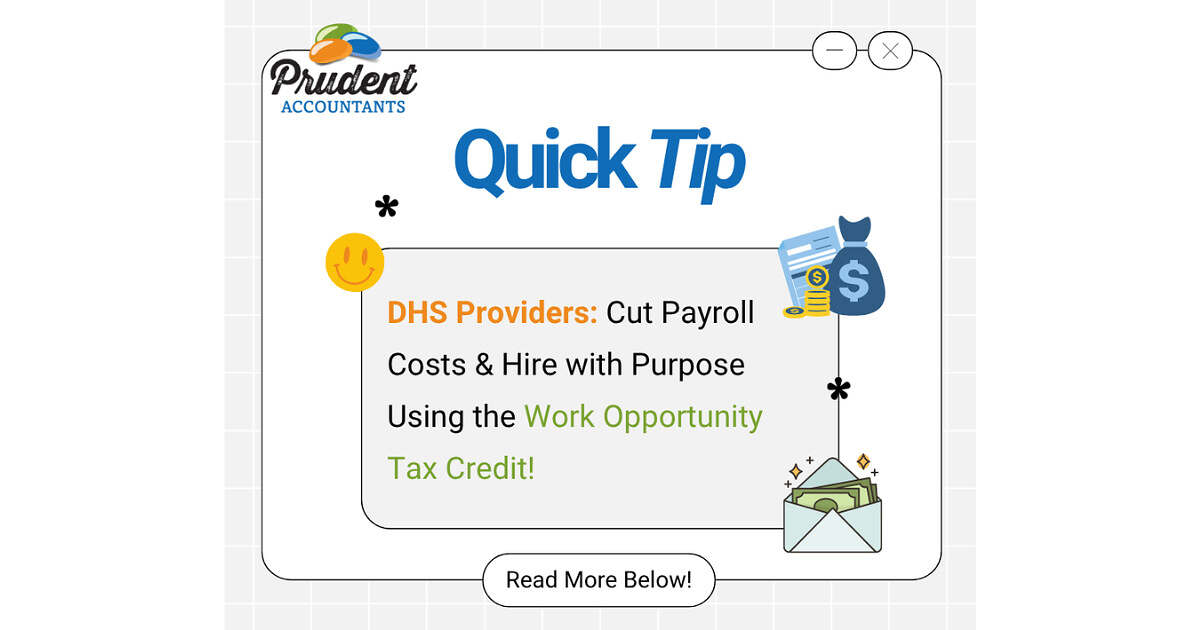Lower Your Payroll, Not Your Standards: WOTC for Community-Focused Employers

If you run a home health agency, daycare, or assisted living business, you know your biggest challenge isn’t clients—it’s keeping good staff.
And you’re not alone. For many providers operating under DHS licenses, workforce costs are skyrocketing. You’re expected to offer competitive wages and benefits just to attract and retain employees, especially in hard-hit employment zones—yet reimbursements from Medicaid or state programs aren’t catching up fast enough.
The result? You’re doing everything right—hiring from the community, investing in your team—but still feeling like you’re falling behind financially.
The Hidden Opportunity: WOTC
The Work Opportunity Tax Credit (WOTC) is a federal tax incentive designed to encourage businesses to hire individuals from certain target groups who consistently face barriers to employment. If you’re a DHS provider, you likely qualify without even realizing it.
WOTC can offer up to $2,400 to $9,600 in tax credits per eligible employee, depending on the category they fall into and how long they stay employed.
So Who Counts?
Many DHS providers already hire from these WOTC-eligible groups:
- Recipients of TANF (Temporary Assistance for Needy Families)
- SNAP (food stamps) recipients
- Veterans
- Long-term unemployed individuals
- Ex-felons re-entering the workforce
- Youth living in empowerment zones
- Supplemental Security Income (SSI) recipients
If your workforce includes team members who meet these criteria, you’re potentially sitting on thousands of dollars in unclaimed credits.
What’s the Catch?
There’s no catch, but the paperwork and timing matter. You must submit IRS Form 8850 within 28 days of the employee’s start date—so it has to be part of your hiring process.
That’s where most business owners miss out. They’re too focused on filling shifts and onboarding quickly (understandably), and don’t have a system in place to capture the credit eligibility window.
But with the right process, this can be completely automated into your hiring flow.
What This Looks Like in Practice
Let’s say you hire 5 new caregivers this year, and 3 of them qualify for WOTC (a conservative estimate for providers in underserved communities). You could earn $2,400–$5,600 per qualifying employee, or roughly $10,000–$15,000 in tax credits.
This isn’t a deduction—it’s a direct reduction in your federal income tax owed. That money can go back into raises, PTO, training, or simply improve your bottom line.
Why This Matters Right Now
Many DHS providers are being stretched to their limits. You’re not only managing care and compliance—but trying to do right by your staff. Payroll keeps going up, but margins aren’t improving. WOTC is one way to create breathing room, without reducing your team or cutting corners.
And if you’re planning for future growth, financing, or a clean exit, these kinds of strategic tax moves increase your enterprise value. Investors and banks want to see healthy margins, proactive tax planning, and systems that support profitability.
You Don’t Have to Figure It Out Alone
If this is the first you’re hearing about WOTC, you’re not alone. Most DHS-licensed businesses aren’t aware they qualify—let alone how to capture it. But the good news is, you don’t have to figure it out on your own.
A strategic financial partner can help you:
- Identify which employees qualify
- Set up an onboarding process that captures credits consistently
- Track and claim credits year after year
- Align WOTC with other workforce strategies and DHS reporting requirements
Final Thoughts
You hire from the heart—and often from the community. That should be rewarded, not penalized. WOTC is a way for the federal government to recognize that work, and for your business to recover part of the cost of doing good.
If payroll is your biggest cost—and your biggest stress—it’s time to explore whether you’re leaving money on the table. WOTC is just one tool that can make a real difference.
